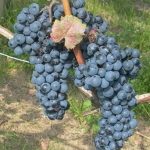Another step in the TCN’s journey along the indigenous grapes of Croatia on October 20, 2016, with another one of Hvar’s almost forgotten treasures: darnekuša.
One of the many indigenous grape varieties on the Croatian islands is Drnekuša or Darnekuša, a red grape found almost exclusively on the island of Hvar. Genetic testing has proven that it is an indigenous grape related to Plavac mali and Bogdanuša, and it has also shown that a variety found on Vis, called Glavanjuša, is actually genetically equal with Darnekuša. The historic records show that, unlike other indigenous varieties of Dalmatia, it was never really cultivated anywhere other than those two islands.
And, obviously, the production of the wine from the grape is not huge, for both the reason of very narrow location where it’s grown, and also because more popular varieties (and sturdy) pushed it out of the way. In the past it was not used to make varietal wines, it was highly thought of as a part of the blend used to make prošek. The yield is quite high and the quality of the grapes is rather high on the good years, when the conditions are optimal, since it reacts to bad conditions and is prone to a lot of diseases. It was traditionally used to increase the quality of other local wines, including Plavac Mali, and that is where it’s still usually found, in Plavac Mali vineyards, as it is rarely planted on its own.
One of the first recent winemakers on Hvar who started making the varietal wine using Darnekuša is Ivo Duboković, whose Laganini is a very light red wine (which explains the name), alcohol content of mere 11,5%, grown in Svirče, with interesting strawberry and cherry flavour with the Mediterranean herbs on the nose. Other winemakers that have been producing varietal Darnekuša on the best of years, when it has the potential to stand on its own are Plančić (his Darnekuša was a bit stronger, at around 15% alcohol content, and some of his vintages were aged in oak; he’s not making them any more but his 2004 and 2005 are dearly remembered), and Carić, who decided to make a rose in 2012. And, yes, there is another very significant Darnekuša rose out there, Rosina made by the Master of Wine Jo Ahearne, a true gem if we are to trust those who have tried it and are looking forward to the full-bodied red to be ready.










